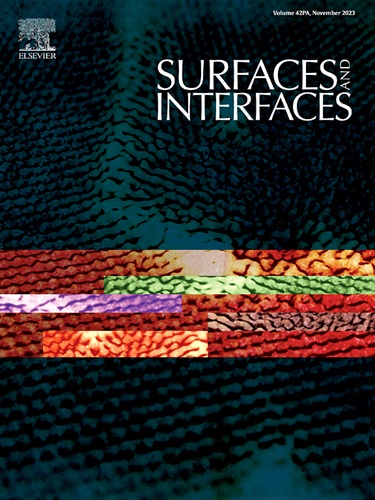High-temperature stability of Ca3TaGa3Si2O14 in various atmospheres up to 1000 °C
IF 5.7
2区 材料科学
Q2 CHEMISTRY, PHYSICAL
引用次数: 0
Abstract
The effect of high-temperature annealing under various conditions on piezoelectric CaTaGaSiO14 (CTGS) substrates was investigated. The substrates were exposed to Ar, N, air, O, high vacuum (HV) or H atmosphere at 800 °C and 1000 °C. A comprehensive analysis of the annealed substrates was performed by X-ray diffraction, scanning electron microscopy of the sample surface and scanning transmission electron microscopy in combination with energy dispersive X-ray spectroscopy of cross sections of the substrate surface. In addition, changes of the chemical composition and the electronic properties of the substrate surface were investigated by X-ray photoelectron spectroscopy. The analyses demonstrated a minor degradation of the surface of the CTGS during annealing at 800 °C in HV or in H. This was strongly increased after annealing at 1000 °C. No significant deviation of the CTGS surface was observed for the other annealing atmospheres. A possible change of the chemical reactivity of the annealed substrates in combination with an oxidable material was tested using RuAl thin films deposited on the substrate, which were then annealed at 800 °C in HV. The chemical reaction between film and substrate was not avoided or reduced by the high-temperature pre-annealing. It is concluded that during high-temperature application under certain conditions, especially in HV or H, uncovered surfaces of the CTGS degrade and lead to a reduction of the piezoelectric properties of the substrate and with this of the functionality of the device. Barrier layers are required to prevent the chemical reaction between the substrate and reactive metallic layers on top.

Ca3TaGa3Si2O14在高达1000℃的各种气氛下的高温稳定性
研究了不同条件下高温退火对Ca3TaGa3Si2O14 (CTGS)压电基板的影响。在800°C和1000°C的条件下,将衬底暴露于Ar、N2、空气、O2、高真空(HV)或H2气氛中。通过x射线衍射、样品表面扫描电镜和扫描透射电镜结合基底表面截面的能量色散x射线能谱对退火后的基底进行综合分析。此外,利用x射线光电子能谱研究了衬底表面化学成分和电子性质的变化。分析表明,在800°C HV或H2中退火时,CTGS表面有轻微的降解。在1000℃退火后,这一现象明显增加。在其他退火气氛下,CTGS表面没有明显的偏差。使用沉积在衬底上的RuAl薄膜,然后在800°C的高压下退火,测试了与可氧化材料结合后退火衬底的化学反应活性的可能变化。高温预退火不能避免或减少薄膜与衬底之间的化学反应。结论是,在某些条件下的高温应用中,特别是在HV或H2条件下,CTGS未覆盖的表面会降解,导致衬底的压电性能降低,从而降低器件的功能。需要屏障层来防止衬底和上面的活性金属层之间的化学反应。
本文章由计算机程序翻译,如有差异,请以英文原文为准。
求助全文
约1分钟内获得全文
求助全文
来源期刊

Surfaces and Interfaces
Chemistry-General Chemistry
CiteScore
8.50
自引率
6.50%
发文量
753
审稿时长
35 days
期刊介绍:
The aim of the journal is to provide a respectful outlet for ''sound science'' papers in all research areas on surfaces and interfaces. We define sound science papers as papers that describe new and well-executed research, but that do not necessarily provide brand new insights or are merely a description of research results.
Surfaces and Interfaces publishes research papers in all fields of surface science which may not always find the right home on first submission to our Elsevier sister journals (Applied Surface, Surface and Coatings Technology, Thin Solid Films)
 求助内容:
求助内容: 应助结果提醒方式:
应助结果提醒方式:


